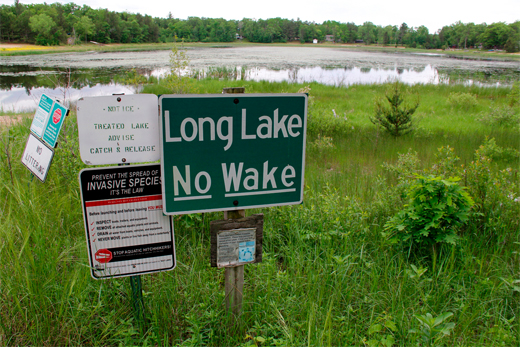University of Wisconsin-Madison is one of the 2014-15 winners of the Challenge Fund for Innovation in Journalism Education. See all 12 winners and the Honorable Mentions.
Team
University of Wisconsin-Madison School of Journalism & Mass Communication:
- Kathleen Bartzen Culver, Assistant Professor
- Deborah Blum, Professor
- Stacy Forster, Faculty Associate
- Lew Friedland, Professor
- Pat Hastings, Faculty Associate
Wisconsin Center for Investigative Journalism:
- Andy Hall, Executive Director
- Lauren Fuhrmann, Public Engagement Director
- Kate Golden, Reporter and Multimedia Director
- Ron Seely, Reporter and Editor
View the final project: The Confluence.
Describe your project as a tweet
Who watches Wisconsin water? @WisWatch & @UWMadison students reporting on quality & supply. Join us at bit.ly/WaterWatchApp & @waterwatchwi
What is your live news experiment?
Launch a yearlong reporting collaboration exploring critical water quality and supply issues.
The project — unprecedented in scope — will connect six to seven journalism courses, Wisconsin Center for Investigative Journalism, Madison Commons, state newspapers, and public and commercial broadcast outlets, as well as volunteer citizen water monitoring.
Our hypothesis is that student reporting in collaboration with industry on a special topic can provide ongoing local coverage while building the foundation for special investigations. Measurement will include reach of stories, community engagement and student evaluation. We also plan a network analysis study pre- and post-project to assess impact.
How will this project reach enough people to make the experiment valid?
By expanding on WCIJ’s existing distribution network and its collaborations with 230 Wisconsin news organizations, this project will bring student journalism directly to local communities.
We will use a community engagement model developed by Madison Commons in both reporting and distributing stories. The goal is to use student and industry reporting as the foundation for social media, events and online discussion spaces to convert widespread but diffuse public concern about water issues into a forum for exploring water quality and supply and for seeking potential solutions to problems.
How is this project unique and innovative?
The project will mobilize unprecedented collaboration between journalism students, instructors and industry professionals.
We have often worked in partnerships like these but only on a small scale in individual courses, powered by a single instructor. This effort is a test of taking that model across multiple courses, working with multiple partners to the benefit of many communities. By using a special topic for local reporting and investigation, we will be blowing out small-scale efforts to test how we might have broad public impact.
This experiment will also test the potential of bringing public and commercial broadcast outlets together with students to expand in-depth broadcast coverage. We also are testing how the collaborative mindset and digital engagement methods used in our courses can translate into newsrooms.

Our classes often use online and social tools for collaboration, reporting and promotion. We want to extend these practices to industry and test their efficacy outside the bubble of academia.
Finally, we will be testing collaboration with volunteer citizen water quality monitors, as well as sensors to gather data for journalism. This kind of pro-am engagement succeeds on our hyperlocal news site, Madison Commons. We seek to test the reliability of citizen monitors and the robustness of engagement on a special topic.
What technology platforms will you use?
WordPress install including the Largo Project; SoundCloud and YouTube channels; Twitter and Instagram accounts; Facebook group (closed) for project participants to enable sharing and troubleshooting and Facebook page (public) to promote work and encourage citizen contributions and crowdsourcing; Tumblr site for covering the reporting process and behind-the-scenes developments; tools for data and story idea submission by citizens; Tableau and Google Maps; StoryMap; Timeline JS; Google Hangouts with experts and affected citizens, archived on our YouTube channel; DocumentCloud; and collaboration and project management tools, including Hangouts, Google Drive and Trello.
All of these tools are currently in use in varying SJMC courses and WCIJ. The goal here is to expand their use across all courses and especially in other Wisconsin media — to take what we have experimented with inside the university and move it outward. The installation of WordPress with Largo is underway with WCIJ, with launch expected in March.
What are the real challenges you face in implementing this?
This marks the first time we will collaborate with WCIJ across multiple classes.
Our first hurdle will be ensuring that collaboration is well-managed, efficient and productive. Second, we will have to work to ensure student stories meet the standards of accuracy, context and integrity necessary to serve communities. Third, this kind of undertaking requires constant reflection, assessment and documentation, so we learn from our successes as well as our mistakes, which will add work to already-strained teaching time.
Finally, reporting on these complex issues can be, pardon the phrase, like trying to hold water. We expect difficulties arising with everything from records requests to jargon-y interviews. But we know from experience that it is in these challenges that students often learn most.
If this project works, how might the media organization and academic institution change its practices?
This project can lead to an expanded relationship between SJMC and WCIJ — one that creates new opportunities for students to develop important multimedia projects that are disseminated to a large statewide audience via WCIJ and its media partners.
With more students in more classes throughout SJMC, stories will have a bigger impact and lead to better education of the students. A year from now, SJMC and WCIJ are exploring ever-growing possibilities for the Wisconsin Idea — the concept that the benefits of the university should extend to the borders of the state and beyond.
Project update: What is the most important impact of your experiment?
We suspect this is yet to come. We engaged an investigative reporting course in a project with the Wisconsin Center for Investigative Journalism to cover well water in Wisconsin and families that cannot drink water from their own private wells. These stories are going through additional reporting and fact-checking this summer with publication aimed for fall. When that series debuts, we will use it as a springboard to promote all the student work on the main Confluence site.

